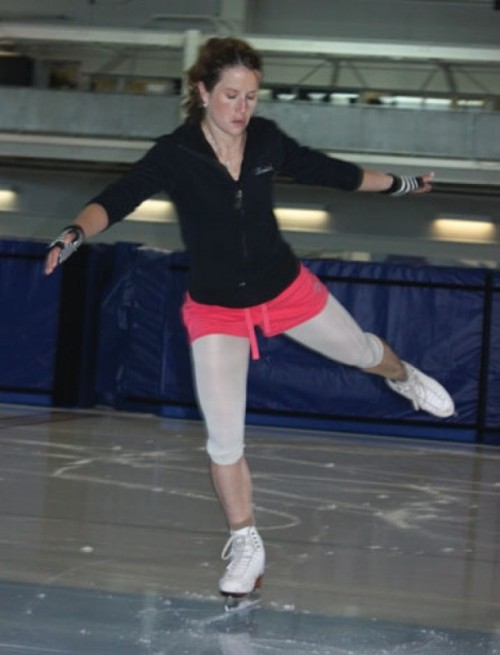The best place to learn is the Olympic Oval in Kearns. It’s a perfect classroom because: 1. The hard, fast ice gives instant feedback for your every move; 2. Unlike a field or a hill, the track is flat and unchanging, so once you get used to the slippery surface, terrain isn’t a factor; and 3. The Oval is more than 1,300 feet around and nearly 40 feet wide, so it offers a large area for learning the physics of movement. In addition, it’s rarely crowded and there’s a long stretch between turns.
Now the key: This is not about skating! Yes, you wear skates for the “lesson,” but it’s what you experience on those blades that teaches the physics of sport. Skates and ice provide the quickest, most precise lessons for both mind and body. To improve, your body must do, but your mind must know why.
Example: It’s hard to isolate the effect of what happens when you put your torso and head in various positions. But it’s an important lesson, because every sport requires some direction change. You’ll be quicker and more agile if you know how to use your upper body mass to aid direction change (your head alone weighs more than 10 pounds).
First lesson: Glide straight down the ice. Turn your shoulders to the left. You may be surprised that you begin turning left without ever moving your feet. Now, starting at the hips, turn your entire upper body to the right. Did you change direction more quickly than you did just using just your shoulders? Think about what that means. Now, add speed to the lesson. Make the same movements while skating faster. You may be unstable at first, but the ice will eventually teach you the physics of speed.
Next, make deliberate turns across the track, from one edge to the other as you skate around the oval (watching for other skaters). This time, twist your upper body away from the turn. Note how much harder it is to execute the turn, and how much slower you are. Repeat until your muscle memory and mind grasp the physics of using your upper body to stop momentum.
Another important lesson: examining balance. Start by skating on one foot for as long as you can. Then switch to the other foot. Is it harder to glide on one leg? If so, that means your balance is off—a definite setup for eventual injury. Start correcting this immediately, because the longer you let it go, the more work it will take to equalize left and right side balance.
The Oval is a perfect place to work on this problem. Start by repeatedly skating as long as possible on the wobbly leg before needing support from the other foot. Soon, you’ll be able to skate longer on the weak leg; many more practice sessions may be necessary before this gets conditioned into your muscle memory. At the same time that you’re learning better balance on your weaker side, you’re also building up weaker muscles.
In addition, take advice from Rebecca Dearing. When this columnist first saw her six months ago, she was wobbly, tentative and often fell. Today, she spins and turns with confident grace. The difference? She spent time experimenting while skating. “Don’t be afraid to try something new,” she says—meaning, don’t just practice the same thing repeatedly, merely trying to do it better. Instead, work on something totally different, like the physics of a spin or the finesse of doing a one-legged squat while gliding on a thin skate blade.
Finally, visualize yourself doing your sport as you skate. Don’t waste your attention on the skating, or the condition of the ice; mentally practice your sport, using what you’ve already been taught by the ice. Don’t stop after one session; keep practicing at the Oval to thoroughly condition body and mind to integrate what you’ve learned. When you get back on the field, road, trail, snow or wherever you play, you’ll be amazed by what you’ve gained from your lessons in physics.
Speaking of...
-
DC vs. Marvel
Why fight? We're on same nerdy team
- Jul 9, 2012
-
Pinot & Pedicures
Tasting Robert Sinskey Wines in the most unusual of venues.
- Apr 26, 2011
-
Everest Nuage Tibetan Restaurant
Tibetan food meets teppanyaki in downtown Salt Lake City.
- Mar 14, 2011
- More »
More by Wina Sturgeon
-
Conquer the Superpipe
Some advice to help you take the plunge
- Jan 8, 2013
-
Park City Shortcuts
Bypass the traffic and be on your way
- Dec 24, 2012
-
Ride the Terrain Park
Start learning or polish your skills
- Dec 11, 2012
- More »



